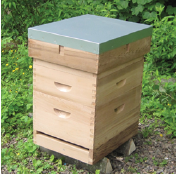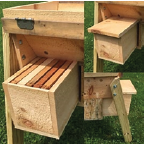
Bees keeping or Apiculture

Apis is a Latin word for bees. Honey bee is Apis mellifera
Terminology
Apiary/bee yard is a place where a number of bee colonies are kept
Bee keeping is the art and science of managing bees for honey, wax, and royal jelly production.
Apiarist is the bee keeper.
Bee baiting is the act of attracting bees to a hive by providing dummy larvae.
Brood is the early stages of bee larvae.
Brood comb is waxy comb from brood chamber of a hive containing brood
Caste is the type or member of the colony like drone, worker, queen
Colony is a group worker, queen and drones living together as a family
Taxonomy
Kingdom Animalia
Phylum Arthropoda
Class Insecta
Order hymenoptera
Family Apoidea (social insects)
Genus Apis (honey bees)
Species mellifera (Ugandan honey bees)
Importance of bees
- Production of honey, pollen, wax and royal jelly.
- Bees pollinate crops
- Bees contribute to agro-tourism
- Bee keeping provide employment
- Bee keeping is a source of income
- Bees provide products for treatment of human diseases (apitherapy)
- Bees are being used in modern warfare in detection of explosives and narcotics
- Entomological research.
Members of a bee colony
- Queen: is the largest bee in the colony used for production of eggs (workers eggs are fertilized while drones’ eggs are not)
- Drone: is the male bee that mates with the queen
- Workers: are the smallest and most numerous in the colony
Functions of young workers in hive
- Cleaning cells for re-use
- Nursing the grub by feeding them royal jelly
- Secretion of bees wax
- Receiving nectar
- Receiving nectar which the foragers bring and converting it into honey
- Cooling the hive
- Guarding in front of hive ready to sting any intruder.
General duties of workers
- Cell cleaning
- Brood, queen and drone feeding
- Build combs
- Collecting and processing nectar into honey
- Defend colony against intruders
- Regulating temperature
- Foraging: collecting pollen as a protein source, nectar as energy sources, water to dilute honey
Source behavior of bees
Swarming: is the movement of bees from one place to another looking for new bee hive.
Causes of swarming
- Overcrowding
- When there is no enough room to build enough honey store
- The temperature is too hot. With higher temperatures, more space is needed for each bee to maintain a cooler temperature.
- The hive does not have proper ventilation and drainage.
- Outbreak of pests like mites
- Sick and infertile queen
- Strong bad odor can chase away bees
Prevent & control swarming
- Always give your bees plenty of room. Bees need room to rear brood, store honey, nectar, and pollen, and produce beeswax. If in doubt, add more room! Too much room is better than not enough, but if you notice bees aren’t moving into their new space, it may be too much.
- When bees are in the process of building up the colony and growing, they should get a good amount of sunlight and warmth. Later on, during the honey flow periods, it may be necessary to shade the hives if you live in a very warm climate.
- Give your colonies plenty of good ventilation in warmer weather. Take out entrance reducers during hot periods and try staggering the supers so they are not flush on top of each other—this allows more air flow.
- Maintain good air flow and drainage to the hive at all times. Keep grass trimmed around the hive and place the hive in an area that gets good air flow. Placing your hive on ahive stand can also help the hive stay ventilated.
- Use young queens if possible. Older queens have a tendency to fail during times of high growth and egg laying.
- Control pests and disease
Bee hives
Hives are houses for bees
The qualities of an ideal beehive
- Should be enough to accommodate comfortably the bee colony
- Should be durable made of hard wood
- Wall surface should be smooth
- Free from cracks and gaps between joints
- Should provide a dark and warm atmosphere inside
- Should be leak proof.
Factors affecting the choice of beehive
- Availability of capital
- Environmental conditions in apiary
- Knowledge and skill of the farmer
- Level of production
Traditional hives (fixed comb hives)
These include
- Long hive: a tree is felled and cut into cylindrical or truncated conical shape.
- Basket hive: woven flexible stick in cylindrical or truncated conical shape
- Grass hive woven dry grass in cylindrical form
- Clay-pot hive
- Gourd hive
Advantage of traditional hive
- They are cheap to buy
- They are easy to make
- They are not easily attacked by ants
- The colony is not constantly disturbed by the beekeeper.
Disadvantages of traditional hives
- Combs with brood are easily damaged
- It is difficult to control swarming
- The colony cannot be easily inspected
- Poor quality honey harvested
Improved bee hives
(a) The Langstroth beehive

It is made of
- Bottom board: a wooden stand on which the hive rests
- Frames and foundation: wooden frames hold sheets of bees wax
- Queen body/brood chamber: a large wooden body for bees to rear brood and store honey for their own use.
Advantages of Langstroth beehive
- Easy to use and move if needed
- Seeking advice and support is easy, as there are many resources available
- Parts and equipment are widely accessible and affordable since it’s the most popular type of hive
- Great yield of honey with this type of hive
- Greater flexibility and control for beekeepers, who actively manage their hives throughout the nectar-flow season
- Very few bees are crushed during hive manipulation
- The queen and brood undisturbed during honey harvesting
- Difficult to steal
Disadvantages of Langstroth beehive
- Expensive
- Require skill to make
- Require much equipment to extract honey
Reasons for fixing of a queen excluder in a beehive
- It helps to confine the queen to lay eggs only in the brood chamber leaving the supers only for honey storage
- It ensures clean honey in the supers free from brood
- Wax harvested is clean
- It allows honey harvesting without much disturbance to the queen and the brood
- It encourages the queen to lay more eggs thus increasing the bee population and honey production.
(b) The top bar beehive

Advantages of top bar hive
- The combs can easily be removed from the colony for inspection and replaced
- Honeycombs can easily be harvested easily without disturbing the brood nest
- Honey quality is improved since pollen and brood combs are not included in harvest
- It is easy and quick to inspect
- Bees are more docile during inspection since a small opening is made
- Simple to construct and cheap
- If necessary, a queen extruder can be fixed to separate the honey from the brood
- Can easily be fitted with movable colony divider to provide more for a bee colony to grow.
Factors to consider when sitting an apiary
- Accessibility to water because bees need water for honey.
- Nearness to flowering plants to provide pollen and nectar
- Direction of the sun. Beehive should be placed facing north-south to avoid direct light and heat.
- Beehives need quiet place.
- Beehive should be placed in places with no strong wind.
- Beehive should be placed a safe distance from homestead and animal places to protect people from bee bites
- Beehive should be place in a place less humid place to prevent fungal infection.
- A beehive should be accessible to the farmers to harvest honey.
- Security from thieves
- Beehives should be protected from fire and smoke.
Methods used to encourage bees to colonize a hive
- Baiting: different baits are used to attract bees to the hive such honey and lemon grass.
- Providing a good environment in and around the hive i.e. cool dark environment
- Planting flowering plants: bee prefer to inhabit hives close to the flowing plants
- Placing a hive near a source of water
- Control predators like birds
- Capturing and placing the queen in the hive
- Using of pheromones in the new hive to attract bees in the hive
- Capturing and transferring a swam into the hive.
Honey harvesting
Precautions taken during honey harvesting
- Harvest when the honey is ready i.e. smell of honey, when bees are more aggressive than usual
- Provide protective clothing: Wear a long-sleeved shirt, gloves, long pants, and closed-toe shoes to protect your skin.
- Do not harvest during rain because water dilutes the honey
- Use suitable smoker
- Remove dirt from honey
- Avoid propolis and too much pollen in honey
Steps in harvesting honey
- Inspect honeybee colonies. Put on protective gear to protect yourself from potential stings.
- Use a bee smoker to scare away bees.
- Take out honey frames from the apiary.
- Remove wax caps from the honeycomb cells.
- Extract the honey.
Uses of honey
- Food
- Health benefits such as healing cough and wound
- Sweetening agent in pharmaceuticals and food
- Flavoring agent in pharmaceuticals and food.
Please find free downloadable notes, exams and marking guides of agriculture, biology, chemistry from digitaltachers.co.ug website.
Dr. Bbosa Science

I’m excited to see where you’ll go next. Electronics
Your content never fails to inspire me. Indian Football
Discover the MBBS Fees Structure in Sikkim, offering quality education at reasonable costs.
Discover how to fast-track your education through MBBS Direct Admission in Bihar.
Experience top-notch gaming with the easy-to-use Raja Luck App.